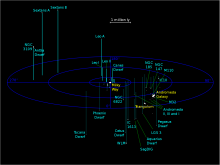Listen to today's episode of StarDate on the web the same day it airs in high-quality streaming audio without any extra ads or announcements. Choose a $8 one-month pass, or listen every day for a year for just $30.
You are here
Palomar 5
Our solar system inhabits the bright disk of a giant spiral galaxy, the Milky Way. The disk is surrounded by a halo of much older stars. There’s also a halo of dark matter. The dark matter emits no light, but scientists know it’s there because of its gravitational pull on the visible matter that’s close to it. From that pull, we know that dark matter outweighs all the rest of the galaxy put together.
An ancient star cluster is helping reveal the shape of the Milky Ways’ dark halo.
The star cluster is Palomar 5, and it’s in serious trouble: It’s losing most of its stars. A stream of escaping stars stretches tens of thousands of light-years across the halo.
Palomar 5 is about 75,000 light-years from Earth, in the constellation Serpens. The cluster hovers high above the galaxy’s wide, flat disk.
The stars that are escaping from it feel the gravitational pull of the dark matter in the halo. So their exact path reveals the shape of the dark halo. The path suggests that the halo is roughly spherical. That’s unlike the galaxy’s disk, which is shaped like a pancake.
Astronomers estimate the cluster has lost more than 90 percent of its stars. So today, the cluster harbors only about 4300 times as much mass as the Sun.
Still, the disintegrating star cluster is helping astronomers figure out the shape of one of the most mysterious parts of the Milky Way.
Script by Ken Croswell





